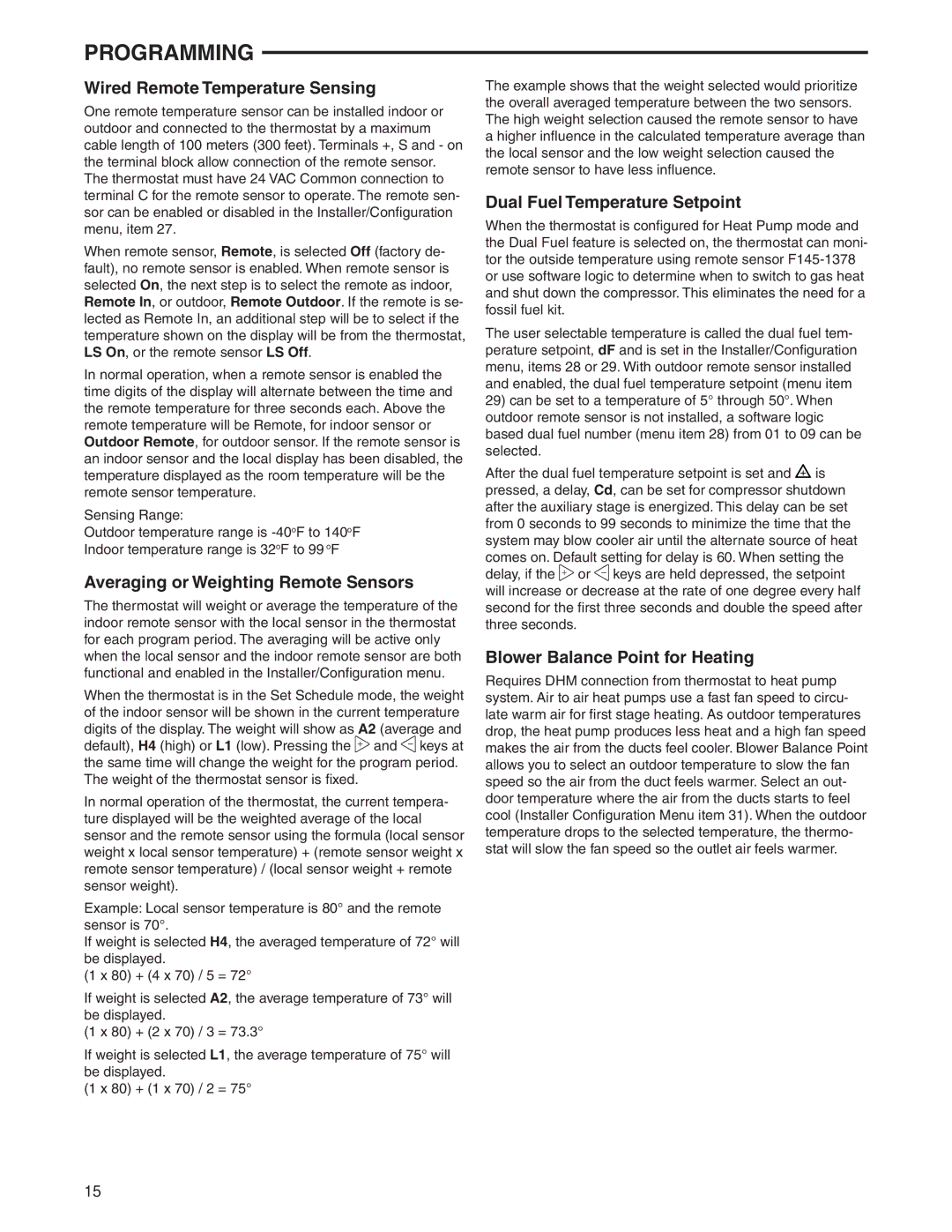PROGRAMMING
Wired Remote Temperature Sensing
One remote temperature sensor can be installed indoor or outdoor and connected to the thermostat by a maximum cable length of 100 meters (300 feet). Terminals +, S and - on the terminal block allow connection of the remote sensor. The thermostat must have 24 VAC Common connection to terminal C for the remote sensor to operate. The remote sen- sor can be enabled or disabled in the Installer/Configuration menu, item 27.
When remote sensor, Remote, is selected Off (factory de- fault), no remote sensor is enabled. When remote sensor is selected On, the next step is to select the remote as indoor, Remote In, or outdoor, Remote Outdoor. If the remote is se- lected as Remote In, an additional step will be to select if the temperature shown on the display will be from the thermostat, LS On, or the remote sensor LS Off.
In normal operation, when a remote sensor is enabled the time digits of the display will alternate between the time and the remote temperature for three seconds each. Above the remote temperature will be Remote, for indoor sensor or Outdoor Remote, for outdoor sensor. If the remote sensor is an indoor sensor and the local display has been disabled, the temperature displayed as the room temperature will be the remote sensor temperature.
Sensing Range:
Outdoor temperature range is
Indoor temperature range is 32oF to 99 oF
Averaging or Weighting Remote Sensors
The thermostat will weight or average the temperature of the indoor remote sensor with the local sensor in the thermostat for each program period. The averaging will be active only when the local sensor and the indoor remote sensor are both functional and enabled in the Installer/Configuration menu.
When the thermostat is in the Set Schedule mode, the weight of the indoor sensor will be shown in the current temperature digits of the display. The weight will show as A2 (average and default), H4 (high) or L1 (low). Pressing the ![]() and
and ![]() keys at the same time will change the weight for the program period. The weight of the thermostat sensor is fixed.
keys at the same time will change the weight for the program period. The weight of the thermostat sensor is fixed.
In normal operation of the thermostat, the current tempera- ture displayed will be the weighted average of the local sensor and the remote sensor using the formula (local sensor weight x local sensor temperature) + (remote sensor weight x remote sensor temperature) / (local sensor weight + remote sensor weight).
Example: Local sensor temperature is 80° and the remote sensor is 70°.
If weight is selected H4, the averaged temperature of 72° will be displayed.
(1 x 80) + (4 x 70) / 5 = 72°
If weight is selected A2, the average temperature of 73° will be displayed.
(1 x 80) + (2 x 70) / 3 = 73.3°
If weight is selected L1, the average temperature of 75° will be displayed.
(1 x 80) + (1 x 70) / 2 = 75°
The example shows that the weight selected would prioritize the overall averaged temperature between the two sensors. The high weight selection caused the remote sensor to have a higher influence in the calculated temperature average than the local sensor and the low weight selection caused the remote sensor to have less influence.
Dual Fuel Temperature Setpoint
When the thermostat is configured for Heat Pump mode and the Dual Fuel feature is selected on, the thermostat can moni- tor the outside temperature using remote sensor
The user selectable temperature is called the dual fuel tem- perature setpoint, dF and is set in the Installer/Configuration menu, items 28 or 29. With outdoor remote sensor installed and enabled, the dual fuel temperature setpoint (menu item
29)can be set to a temperature of 5° through 50°. When outdoor remote sensor is not installed, a software logic based dual fuel number (menu item 28) from 01 to 09 can be selected.
After the dual fuel temperature setpoint is set and![]() is pressed, a delay, Cd, can be set for compressor shutdown after the auxiliary stage is energized. This delay can be set from 0 seconds to 99 seconds to minimize the time that the system may blow cooler air until the alternate source of heat comes on. Default setting for delay is 60. When setting the delay, if the
is pressed, a delay, Cd, can be set for compressor shutdown after the auxiliary stage is energized. This delay can be set from 0 seconds to 99 seconds to minimize the time that the system may blow cooler air until the alternate source of heat comes on. Default setting for delay is 60. When setting the delay, if the![]() or
or![]() keys are held depressed, the setpoint will increase or decrease at the rate of one degree every half second for the first three seconds and double the speed after three seconds.
keys are held depressed, the setpoint will increase or decrease at the rate of one degree every half second for the first three seconds and double the speed after three seconds.
Blower Balance Point for Heating
Requires DHM connection from thermostat to heat pump system. Air to air heat pumps use a fast fan speed to circu- late warm air for first stage heating. As outdoor temperatures drop, the heat pump produces less heat and a high fan speed makes the air from the ducts feel cooler. Blower Balance Point allows you to select an outdoor temperature to slow the fan speed so the air from the duct feels warmer. Select an out- door temperature where the air from the ducts starts to feel cool (Installer Configuration Menu item 31). When the outdoor temperature drops to the selected temperature, the thermo- stat will slow the fan speed so the outlet air feels warmer.
15
